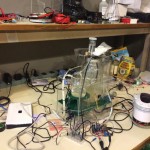What Three Biotechs could inform Us about the Pfizer-Allergan Merger

The lengthy-speculated Pfizer-Allergan merger, announced closing week with a $ a hundred and sixty billion price ticket, is officially in motion and lurching toward inevitability.
Inevitability doesn’t equal certainty for a lot of involved within the deal. Tens of heaps of staff could doubtlessly get the axe, while dozens of smaller corporations partnered with the 2 behemoths wait to peer if their programs live on a portfolio shakeout. I’ll element three of them in a moment.
out of the ordinary political force may derail the report-breaking deal, but, as U.S. Treasury Secretary Jack Lew made clear in a letter closing month, Congress must act, and—-adequate, you could cease laughing already.
There indisputably shall be huffing and puffing over corporate tax evasion—er, inversions—and national loyalties. (The deal would turn Pfizer into an Irish-domiciled firm and shrink its tax invoice.) look forward to officials from Pfizer (NYSE: PFE) and Allergan (NYSE: AGN) to all however tattoo American flags on their foreheads in embarrassing makes an attempt to stave off criticism. The day of the announcement, head honchos Ian read (CEO, Pfizer) and Brent Saunders (CEO, Allergan) wasted no time on CNBC invoking the deal’s advantages for america. (For just right measure, read squeezed in a plug for “the security of youngsters.”)
the us! Innovation! kids! unfortunately, clear sanctimony isn’t more likely to scupper the Pfizer-Allergan deal to any extent further than the shameless tax steer clear of will.
Then there are the companies’ employees, who have each right to be concerned. in line with a FiercePharma tally in 2014, Pfizer’s previous megamerger—the $ 68 billion deal with Wyeth in 2009—sliced headcount from virtually a hundred thirty,000 employees combined to about 78,000. promoting or hiving off divisions such because the animal well being staff Zoetis (NYSE: ZTS) accounted for 18,000 of the 51,000 job cuts, layoffs the remainder.
needless to say what helped Pfizer find the money for to buy Wyeth? Billions of greenbacks, repatriated from overseas in a one-time tax vacation the pharma industry lobbied for aggressively. It used to be a part of—wait for it—The American Jobs introduction Act of 2004.
After the binge comes the purge.
In theory, ability and belongings could be unlocked from bloated company buildings, but on the bottom, the lives of employees with families and different urgent obligations may also be disrupted on the worst conceivable moments, all without the golden parachutes bestowed upon those within the C-suites.
the future of smaller corporations, too, can lie within the steadiness when behemoths collide. Biotechs partner with pharmas all the time, buying and selling rights to their work for far-wanted cash and different issues. from time to time their packages stay excessive priority within the newly merged company. every now and then they’re shelved and get stuck in limbo, as biopharma veteran Francois Nader discussed with Xconomy last year.
on occasion the rights to those applications are punted back to the biotech, which will also be excellent or bad. One example of each: German antibody drug maker Micromet saw its major building companion obtained way back in 2003.
The acquirer severed ties with Micromet and despatched the German firm into scramble mode, laying off a 3rd of its employees. but Micromet survived. In 2012 Amgen offered it for greater than $ 1 billion and in 2014 obtained FDA popularity of its lead drug, blinatumomab (Blincyto), to treat a uncommon form of leukemia.
submit-merger, the upheaval may closing a while on the new company, to be able to keep the Pfizer identify. the two facets have talked brazenly about massive restructuring in the following couple of years after the preliminary mud settles. Add regulatory delays, perhaps, to the uncertainty for smaller companions, and it spells fearful occasions for dozens of biotechs waiting for signs that their products are making progress or their supporters within the new firm are keeping their jobs.
There are three biotechs partnered with Pfizer or Allergan that I in finding in particular intriguing for more than a few causes: Claims of getting supporters, or “champions” on the easiest reaches of the new company. applications that might discuss volumes, whether dropped or supported, concerning the mixed “Pfizergan” appetite for possibility. the most important ties to the brand new firm that may be devastating if severed.
the first is Cellectis. The French gene modifying firm touched down within the U.S. this spring, establishing lab space in new york to go together with its profitable Nasdaq IPO.
exhausting to think about that any Pfizer or Allergan accomplice might be watched more closely in the wake of the merger, due to shocking information remaining month that Cellectis’s T cell immunotherapy product, dubbed UCART19, saved the lifetime of Layla Richards, a British infant whose acute lymphoblastic leukemia had no longer replied to different remedies.
The determined intervention was once now not a part of a scientific trial; it was once a different request—what’s called “compassionate use” within the U.S.—with the aid of Layla’s parents to check out something that had never been tested in people before. This summer time, UCART19 introduced Layla again from the brink and allowed medical doctors to check out again a bone marrow transplant, which hadn’t labored previously. As of November, her most cancers was once in remission. (docs will present the case this weekend at the American Society of Hematology’s annual assembly in Orlando, FL.)
Cellectis is tied to Pfizer in two ways. Two weeks after news about Layla Richard broke, Pfizer finalized a deal for U.S. rights to UCART19, now Cellectis’s most promising product. thanks to a 2014 maintain Servier, the French pharma had the method to take full rights after section 1 trials. When it induced that choice ultimate month far previous than anticipated, Servier additionally stated it offered U.S. rights to Pfizer. reworking the choice brought Cellectis additional cash upfront, more potentially down the road, and lifted the biotech’s burden of purchasing section 1 trials for UCART19, which might doubtless value tens of thousands and thousands of dollars, Cellectis CEO André Choulika told me.
So building of UCART19 is totally out of Cellectis’s palms, even if Choulika stated he tried to win back the U.S. rights when Servier was taking bids. “i tried to bid also, despite the fact that we had no advertising and marketing power within the U.S., no industrial presence,” Choulika stated. “We have been became down several occasions by Servier, they could do no matter they wished.” Pfizer and Servier will share prices and advertising duties, if the treatment gets that a long way. Pfizer will take the U.S. market, Servier far and wide else.
now not most effective will Cellectis rely on Pfizer to convey the unexpectedly excessive profile UCART19 to market, it additionally needs Pfizer’s lend a hand to carry some other huge chunk of its pipeline to fruition. In 2014, the businesses signed a sweeping deal in which Cellectis amassed $80 million upfront, was promised a ways extra if their joint efforts came to market, and noticed Pfizer take a 10 p.c stake in the company.
Pfizer took the plunge as a result of Cellectis’s model of automotive-T therapy—juicing up human T cells to lend a hand a patient’s personal immune device battle off cancer—is thought to be simpler than these in development from Juno Therapeutics (NASDAQ: JUNO), Kite Pharma (NASDAQ: KITE), and Novartis (NYSE: NVS). these corporations are engaged on autologous therapies, which require T cells taken from a affected person, altered outdoor the body, then reintroduced. My colleague Ben Fidler said just lately on one of the vital hurdles, outlined with the aid of consultants at an immunotherapy conference.
Cellectis is going “off the shelf”—harvesting T cells and enhancing them so that they work in a variety of patients. to take action, Cellectis is the usage of a gene enhancing expertise known as TALEN to alter the cells in a few methods, including a genetic exchange to keep them from attacking the patients who obtain the remedy.
Off-the-shelf may well be easier to mass-produce, however what looks as if a deep dedication from Pfizer now must run the gauntlet of committees and within politics, all while neatly-heeled opponents Juno, Novartis, and Kite (with its accomplice Amgen) march deeper into the hospital with their lead merchandise. conversing after read and Saunders published they often is the one-two punch of the brand new Pfizer, Choulika said learn was once a “champion of the deal” and also praised the “chemistry” between Cellectis and Pfizer scientists: “you probably have an exterior view of Pfizer, it’s onerous to consider, but it surely’s a very human firm from the inside.”
The 2d accomplice I’ll profile, 2nd Genome, is also on the Pfizer facet, and in addition providing the pharma giant with an experience in a cutting-facet container of research: the microbiome.
obesity, diabetes, and other metabolic illnesses are an incredible health drawback, and a brand new crop of weight-loss medication, based on conventional drug chemistry, have confirmed disappointing.
The mixed Pfizer-Allergan would have zero metabolic medicine under its roof, in line with slides offered on the merger press convention. They’re nonetheless a high area of passion, however. despite cutting back its therapeutic areas after the Wyeth deal, Pfizer has maintained a analysis team for cardiovascular and metabolic disease, run with the aid of Morrie Birnbaum, a diabetes professional who got here from the university of Pennsylvania.
could the microbiome be Pfizer’s method in? second Genome of South San Francisco was once in the beginning founded to pursue microbe-based totally environmental cleanup, however the biotech is now developing traditional small molecules that alter the way in which microbes have interaction with the gut to create or exacerbate illnesses. beyond its nascent scientific program for Crohn’s disease, second Genome has been working on metabolic analysis with Pfizer. introduced in may 2014, the 2 are learning 900 individuals recruited through Massachusetts common health center whose metabolic profiles—of various states of disease or wellbeing—are well-known. To the sufferers’ current profiles, Pfizer and 2nd Genome have introduced details about the bugs in their guts, the proteins the bacteria are secreting, and more. It’s not a part of a medical find out about, but it’s a deep dive to “remember what the bugs are doing in the context of disease,” 2nd Genome CEO Peter DiLaura instructed me lsat yr.
And now? DiLaura declined to offer updates on the challenge or comment on the merger.
(DiLaura is showing with whole Biome CEO Colleen Cutcliffe at our Dec. 10 EXOME adventure, the Bay space’s lifestyles Science Disruptors, to speak about constructing their microbiome therapeutic startups—two of the few thus far to emerge from the brand new container.)
bearing in mind how initiatives—especially centered on early stage, high risk science—can enter a state of limbo all through the lengthy merger process, it could be striking if in coming months Pfizer committed more tools to the collaboration. but if Pfizer punts, it wouldn’t seemingly be a huge blow to 2nd Genome, which has already secured a deal with the enormous Pharma most devoted to microbiome work, Johnson & Johnson.
The 0.33 partner I’ll spotlight has built what seems to be extra an important ties to the brand new Pfizer. Medicines360 of San Francisco is trying something new, and it needs the Allergan gross sales force to prevail. The nonprofit won FDA approval this yr for an interuterine contraceptive tool, or IUD, on the potential of a huge phase three trial funded by an nameless donor. however Medicines360 desires to be self-sustaining because it pursues its goal of bringing extra contraception, and fewer undesirable pregnancies, to younger, lower profits girls in the U.S. and in another country. I described the unique industry version here; Allergan’s key position is to sell the software, branded as Liletta, to non-public clinics at market charges.
the first gross sales started in April. Medicines360 CEO Jessica Grossman declined to provide specifics but said gross sales have beaten Allergan’s preliminary forecast.
Medicines360 is using its minimize of these gross sales to provide the IUD to public health clinics for a flat $50. They typically price a whole bunch of dollars, mentioned Grossman. The cheaper price lets the health center go financial savings to their clients and even supply the IUDs totally free. however there’s a 2nd merit: It additionally allows the clinics to stock the IUDs prematurely so girls asking for them don’t have to return again—the most important for girls with restricted instruments or working multiple job. “Our value is all about having an reasonably priced product on the cabinets of the medical institution,” said Grossman.
Medicine360’s unique collaboration was with Actavis, which sold Allergan in June and adopted the identify. When Liletta launched in February, an Actavis spokesman told Xconomy it had seven women’s well being products and gross sales contacts with 25,000 U.S. healthcare providers.
in keeping with Allergan’s newest financial studies, women’s health is its fourth-biggest income generator within the U.S., with $767 million in net sales the first three quarters of 2015. Pfizer has its personal girls’s well being industry, led by its Premarin estrogen tablets.
Grossman mentioned Allergan has been “an incredible associate.” It’s onerous to forecast what occurs when two huge firms collide, but she thinks Liletta’s nonprofit side will enhance the new Pfizer’s for-revenue gross sales, in response to anecdotes from docs that their sufferers “want [the device] instantly” after hearing about “the mission.”
“We really feel comfy there shall be a persisted dedication,” said Grossman.
(52)













